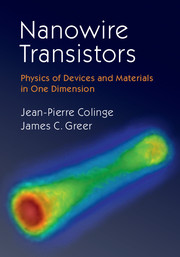Book contents
- Frontmatter
- Dedication
- Contents
- Preface
- 1 Introduction
- 2 Multigate and Nanowire Transistors
- 3 Synthesis and Fabrication of Semiconductor Nanowires
- 4 Quantum Mechanics in One Dimension
- 5 Nanowire Electronic Structure
- 6 Charge Transport in Quasi-1d Nanostructures
- 7 Nanowire Transistor Circuits
- Index
- References
4 - Quantum Mechanics in One Dimension
Published online by Cambridge University Press: 05 April 2016
- Frontmatter
- Dedication
- Contents
- Preface
- 1 Introduction
- 2 Multigate and Nanowire Transistors
- 3 Synthesis and Fabrication of Semiconductor Nanowires
- 4 Quantum Mechanics in One Dimension
- 5 Nanowire Electronic Structure
- 6 Charge Transport in Quasi-1d Nanostructures
- 7 Nanowire Transistor Circuits
- Index
- References
Summary
Overview
Solid-state physics is primarily concerned with the quantum mechanics of bulk materials and surfaces. Molecular physics and quantum chemistry are similarly the application of quantum mechanics to molecular problems. Bulk materials may be described as three-dimensional objects, and their spatial dimensions have a significant influence on the allowed solutions for quantum mechanical energy states or levels. These quantum mechanical levels in three dimensions give rise to electronic band structures which are commonly used to define a material as a metal, insulator, or semiconductor. Energy bands are formed from quantum mechanical states that are nearly continuous in energy. If the states that comprise a band are only partially filled with electrons, a metal is formed. For a fully occupied band separated by a relatively small energy gap, a semiconductor is the result. If the energy gap between a filled band and an empty band is large, the material is described as an insulator. Molecules are zero-dimensional objects with vanishing of the wave function in all three spatial directions and the bound electrons do not propagate. This gives rise to a discrete energy spectrum that is characteristic of molecules; the spacing between energy levels is large and there is no corresponding band picture of the electronic spectrum.
Modern epitaxial growth, lithography, chemical synthesis, self-assembly, and scanning probe techniques allow for the fabrication of material systems that are intermediate in dimensionality to solids and molecules. When electrons or holes are confined in a single direction and are free to propagate in two directions, a two-dimensional electron or hole gas (2DEG or 2DHG) is formed. If electrons or holes are confined in two dimensions and electrons or holes are free to move in a single spatial direction, a nanowire or one-dimensional (1D) structure is formed. In the following, quantum mechanics is introduced with a focus on the physics of 1D or nanowire structures with emphasis on the concepts relevant to engineering transistor structures on the nanoscale.
Survey of quantum mechanics in 1D
Quantum mechanics relies on the use of state vectors to describe a physical system and operators are used to determine physical properties that are measurable. In quantum mechanics, the systems that are subject to measurement are of the same scale as the smallest experimental probes that can be devised.
Information
- Type
- Chapter
- Information
- Nanowire TransistorsPhysics of Devices and Materials in One Dimension, pp. 81 - 106Publisher: Cambridge University PressPrint publication year: 2016
